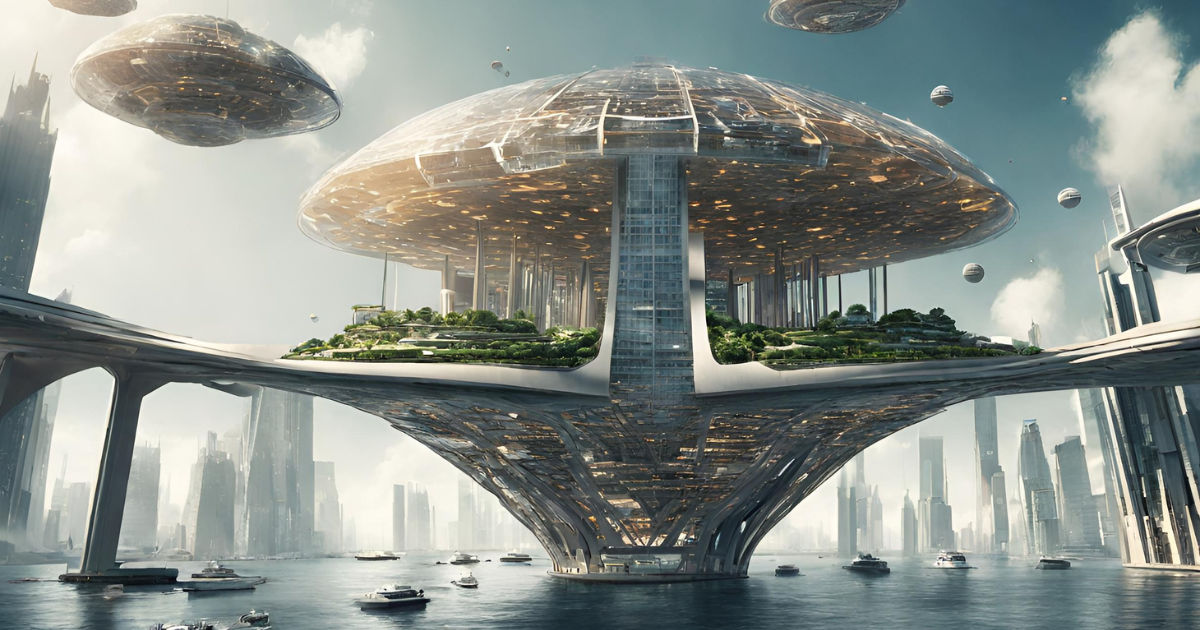
With most cities placed near the coastline and sea levels set to rise by one to two metres in the next eighty years, it has become increasingly important to find a solution to this problem. 90% of coastal cities will be affected by this issue by 2050.
Traditionally, flood defences have been built around cities built on the coast to try and keep the oceans at bay and prevent water levels from rising and flooding the city. Examples of these include
- Shanghai has 520 km of its shoreline lined with protective sea walls
- Hamburg has waterproof buildings and a gate system that closes off the ground floors in case of a flood
- On Manhattan Island in New York, a seven-mile water-repellant ribbon with green parks, leisure facilities, and seating areas has been built around the island to prevent hurricane damage
US expenditure on protecting coastal cities from the rising ocean is expected to be around $400 billion by 2040, which is certainly no drop in the ocean.
What is Seasteading?
Instead of trying to build walls and defences to keep the rising sea out, what if we took the opposite approach and built housing and cities that were floating on the sea?
This may seem like a bizarre and unworkable concept but when you think about it there are already several examples of seasteads in place that work perfectly fine.
Oil rigs can house several hundred people for an indefinite amount of time in a place where they can live and work in a structure built in the middle of the ocean and this is more or less taken for granted as a standard way to do business if you were in the oil industry.
So it doesn’t take a massive leap to turn an oil rig into a more attractive and functional living space, like a floating city. Similarly, cargo ships and cruise ships are circumnavigating the globe day and night with thousands of people who are again living and working on a small floating town of sorts. So it’s not an entirely strange notion to do the same for a larger section of the population when sea level rises and the effects of climate change can be so catastrophic for those living in coastal regions.
Would it be Possible to Float an Entire City on a Big Shipyard?
The short answer here is no, but thankfully that is not what is being proposed. There are several reasons why you can’t just take the weight of New Orleans and put it on the back of a large floating shipyard-type structure—apart from the weight sinking the shipyard 300 ft under the water, there would be an issue with waves causing structural failure as they essentially break apart the concrete shipyard.
Put that idea on the maybe pile then.
Another option is to go out into the water and fill it with a load of rock, sand and clay making an artificial island of sorts. This would commonly be known as land reclamation and has worked in the past, for example in the Netherlands, although it is not necessarily the most sustainable and effective method of building going forward.
What is the Solution?
The answer is to have smaller interlinked structures floating on the water as opposed to one large structure that will be affected by waves and currents.
If this all sounds a little too much like Waterworld with Kevin Costner, then it should be pointed out that this is already taking place.
In Amsterdam, architects such as Waterstudio have developed a floating village that is host to 100 people spread across 46 homes floating on the water.
Apart from providing shelter, the city can also sustain itself independently from the mainland—like being on a permanent cruise ship.
In terms of power generation, there’s an interesting technology called ocean thermal energy conversion or OTEC.
This relies on the natural ocean water temperature gradient between the surface and lower depths (approx 25 degrees celsius to 5 degrees celsius) and can generate electricity using a low boiling point substance such as ammonia that is evaporated by the warm water where it feeds into a turbine to power an electrical generator. Cleverly, the cold water in the OTEC loop then cools and condenses the ammonia back to liquid form to be reused, starting the process again.
The waste cooling water can be fed to aquaculture facilities to grow food—fish and algae—and it can also be used to desalinate seawater, providing fresh drinking water, food and energy in one system.
Current Ocean Building Projects
Oceanix City
Oceanex City is a UN-supported floating city project formed by hexagon-shaped islands about 100 metres square, with 300 people on each section.
It will run off renewable energy and have its own services such as healthcare, education, and leisure parks, along with desalination plants and food production systems.
Expected to be operational in 2025, Oceanix City will be able to accommodate 12,000 people. Following a stepwise modular design Oceanix will first develop a six-island village as the core unit of their offshore infrastructure.
The mobile islands will be assembled on dry land and then towed into place, Each unit will support customised, functional edges, that range from plantations to public spaces or marinas. Oceanix City will also include small desert islands surrounding the archipelago that not only protect the islands from wind and waves but also have specific functions like solar energy generation and food production.
Seament the World to Me
One interesting new material being used in these projects is known as bio rock or seament (no we’re not making this up). This really could represent the future of construction in these types of environments and is a very novel way to build.
Bio rock or seament (or seacrete) works very similarly to the old cathode and electrode experiment done in science class with a battery and salt solution.
You get a steel bar and apply a current through it which makes it act as a cathode attracting seawater minerals so you end up with a limestone layer forming around the bar that turns hard like concrete and binds itself to the ocean bedrock.
It also creates a sort of artificial reef providing food and shelter for fish and marine life, whilst allowing the islands to withstand a category 5 hurricane.
Dogen City
Set to open in 2045 Dogen City designed by Toyo Ito will be around 4 km around the circumference and hold up to 40,000 people. The circular structure would include housing, medical research facilities, food production centres and even launch sites for spacecraft, quite ambitiously.
The floating structures inside the ring will be able to be reconfigured depending on the needs of the city and the outer ring itself will act as a tsunami shield protecting the floating developments within.
Understandably this will be quite an expensive development but Toyo Ito has a crafty idea to transform his company into a more product-oriented business like Apple or Microsoft, by making Dogen City a place for medical tourism.
The idea is that with enhanced AI health monitoring and surgical robots, they will draw in the crowds needed to fund the development and maintenance of the project. However, by 2045 these services may be commonplace around the globe and may not necessarily be as much of an attraction if the hospital down the road can provide these sorts of technological-based treatments.
Further to this, Ito also envisions the entire structure will be housing massive data centres under the water. Part of the enormous cost and energy use from datacentres is from the cooling needed so by hanging them underneath these floating islands they are permanently cooled by the seawater around them.
Of course, there are no immediate plans to start building Dogen City and when asked about the overall cost of the project Ito said that he couldn’t give the full figure but that it would be “huge”.
Oxagon
Another giant floating city with more of an industrial purpose is planned in Saudi Arabia called Oxagon. This will be a huge sprawling, futuristic industrial zone built on the sea that will use 100% clean energy and accommodate 100,000 inhabitants in an area around 7 km across. This is expected to be completed by 2030 and is one of several ambitious building projects from Saudi Arabia
How Long Will It Be Till We Are All Living Like Kevin Costner With Gills Behind Our Ears and Wearing Eyepatches and Leather Outfits?
One of the most staggering things about all these developments is not so much the scope and ambition of the projects but the dates set for when they are expected to be completed.
If they were all geared up for construction in a post-2050 world you would be forgiven for thinking that it is just a conceptual design and a wild idea that maybe will provide some inspiration.
However, far from being some abstract theory—the first one of these is planned within the next two years, with another floating city to follow five years later! Some of these developments are already in existence today, such as the floating village in Amsterdam created by Waterstudios and other architects.
The interesting thing with these floating cities is that although the initial cost to build them will be quite high, overall they will be expected to cost less than living on the land due to the lower costs from land prices that are covered in the ocean as opposed to the city or surrounding areas along the coastline.
So living in these futuristic floating cities could actually become a cheaper and more sustainable option, with property prices around £200k in some instances. With their resilience to climate change disasters and rising sea levels, they could be a brilliant solution to the world’s growing population and in housing refugees who have been affected by disasters associated with climate change.
Get in Touch
For the latest information on everything tech and construction-related, find more information here or get in touch with our advisors at Lyon to learn which advanced systems would be of most benefit to your construction business.




